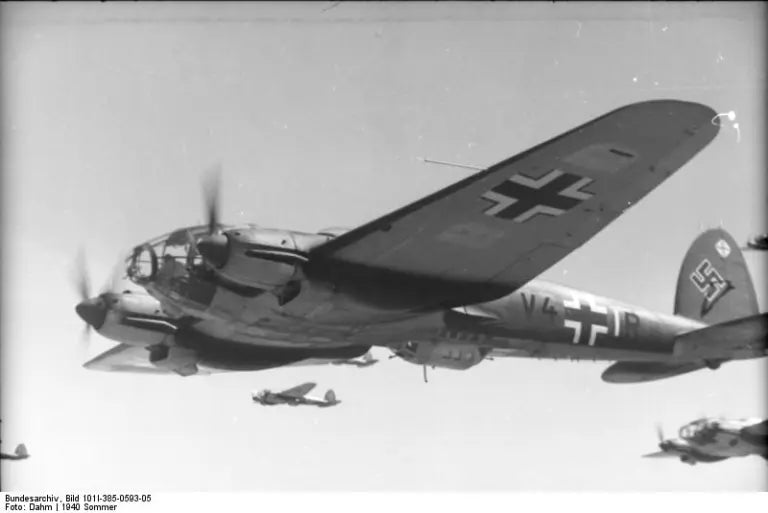Few aircraft have elicited as many diverging opinions as the Heinkel He 111, an aircraft that engendered both awe and disdain during its operational lifetime. A quintessential element of Germany’s Luftwaffe in the Second World War, the Heinkel He 111’s developmental trajectory commenced under far less infamous guidance. The bomber’s earliest renditions took part in a conflict that stands as an ominous prelude to the global carnage that was to follow: the Spanish Civil War (1936-1939).
The Embryonic Heinkel He 111
The Heinkel He 111’s design origins combine deceit and ingenuity. Officially billed as a civilian airliner in the mid-1930s, this was merely a façade orchestrated by Ernst Heinkel to circumvent the limitations imposed by the Treaty of Versailles on German aircraft production. The nascent He 111 featured elegant elliptical wings, a low-drag monocoque fuselage, and Jumo 211 liquid-cooled engines, elements which, when conjoined, created a machine of excellent speed and range.
The Condor Legion and a Theater of Brutality
The Spanish Civil War, pitting the Nationalist forces led by General Francisco Franco against the Republicans, presented an opportunity for Germany to engage in covert experimentation and combat evaluation of its burgeoning arsenal. Dubbed the Condor Legion, a Luftwaffe detachment was dispatched to support Franco, facilitating the He 111’s baptism by fire.
The Heinkel He 111’s engagement in the Spanish theater was not merely an auxiliary tale but a crucible that demonstrated its capabilities and exposed its deficiencies. With the debilitation of the Republican anti-aircraft artillery and fighter resistance, the skies of Spain served as a somewhat untamed domain for the He 111 to enact its deadly performance. This performance included air-to-ground assaults, strategic bombings, and reconnaissance missions.
Operational Lessons and Unintended Consequences
During its operational vacation in Spain, the He 111 exhibited salient strengths and weaknesses. One pivotal episode was the bombing of Guernica on April 26, 1937. This bold attack, which subsequently earned global notoriety, enabled the He 111 to showcase its speed and bomb-carrying capacity. However, it also unearthed questions surrounding the aircraft’s defensive armament, deemed woefully inadequate against more agile enemy fighters.
The myriad lessons learned from the He 111’s sortie in Spain were not merely confined to engineering tablets but seeped into tactical doctrines as well. Realizing the dire need for fighter escorts, advancements in precision targeting, and an appraisal of the efficacy of dive-bombing techniques were just some of the learnings meticulously archived and analyzed by Luftwaffe strategists
From Guernica to World War II: An Unrelenting Evolution
In the shadow of its Spanish sojourn, the Heinkel He 111 underwent a series of iterative modifications that culminated in variants more potent than their Spanish Civil War forerunners. While the He 111 would never completely surmount its weaknesses—limitations that would be egregiously exposed when pitted against the sophisticated anti-aircraft systems and nimble fighters of World War II—it nonetheless persisted as an enduring icon of aerial warfare.
As a precursor of the technological and strategic innovations that would dominate later 20th-century conflicts, the Heinkel He 111’s role in the Spanish Civil War stands as a chilling testament to the interplay between human ingenuity and the machinations of war. An aircraft conceived in deception, born amidst the caldron of a civil conflict, and matured on the anvil of global warfare, the He 111’s Spanish foray was both a prologue and a precursor—paving the way for its more famous and infamous exploits that would unfold against the backdrop of a world at war.
For more insights into the Heinkel HE 111 and other important military aircraft, visit Aces In Action. Here, you’ll find a fantastic piece of artwork by Craig Tinder titled “WWII German Heinkel HE 111,” which illustrates a rare artifact of the HE 111, along with the story of the piece, all combined into an attractive, ready-to-hang wood plaque. The relic included on the plaque is a piece of authentic relic from a Heinkel HE 111 medium bomber discovered at a known crash site approximately 30km South of Vinnytsia, Ukraine, acquired directly from the source and has NEVER been in collectors’ circulation.






Share:
Danger Zone: The Risks and Thrills of Flying the F-14 Tomcat
The Hetzer in the Eastern Front: A Tactical Overview